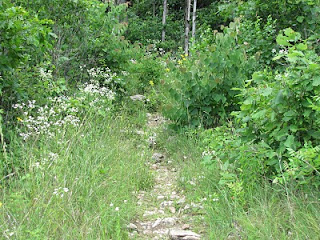There is so much talk about growing native plants these days: what is native, what isn't, what are weeds, what can be called "wildflowers", what natives belong in a home garden and what should best be left in the wild, on and on. In my opinion (which I don't think you asked for, but I'm gonna give it to you anyway, I'm shameless) there are many native wildflowers which can be grown in a garden. But! and here's the caveat: some just aren't suitable or even manageable in a small space. Some of them need room, lots of it! Many need the kind of environment most backyard gardeners can't give them, and may just turn up their toes and die in our nice rich garden soil with all the water they could ever possibly want.....or else, on such a rich diet, go absolutely kick-up-their-heels rampant and try to fill every available corner with their offspring or their greedy roots. A firm hand is needed with these characters. They are native plants because they have adapted to survive under specialized, and sometimes harsh conditions that exist in the local environment. A few actually need fire to germinate!
Prairie wildflowers are among those that survive on neglect, producing zillions of seeds, only a small percentage of which will actually find the right conditions to germinate. In spite of being found in full, intense sun on open prairies, a lot of them are actually shade plants, growing in the shade of tall grasses that tower over them as they complete their life cycles.
Those pictured below are all plants of the midwest. Many of them can be found all over the United States, wherever prairie-like accomodations for these hardy plants can be found: in pastures, on roadsides, empty lots, in sidewalk cracks where you would thnk they couldn't get a root-hold.
. They ask for little more than a bit of soil, sun,
and that it rains once in a while.
The last time we went to Roaring River State Park, here in SW Missouri, we went hiking on the Firetower Trail (between trout fishing). It's a beautiful trail, through richly diverse woods, that eventually winds through a restored dolomite glade area with wonderful native wildflowers blooming in glorious abundance. It is a harsh, rocky area in full, blazing sun with competition from grasses, trees and predators to eat them, but somehow, they survive and are beautiful!
A few, like the puffy pink sensitive briar below, have their own defenses--the stems are thorny and hurtful to touch! Prickly pear cactus, also often found on certain types of glades, is very well armed. Some taste terrible, but all are host plants for some form of insect life or provide habitat for Mother Nature's pets, which feed on the insects that feed on the plants.....in the interconnectedness that is life.
Mimosa nuttallii (sensitive briar, cat's claw)
A wild member of the allium family
Prairie Larkspur
Prairie mallow
Echinacea (cone flower)
Asclepias (Butterfly weed)
Coreopsis
Deptford pink
Ruellia
Yarrow
Prairie rose
Yellow clover
daisy fleabane
The wonderful golden seed puff of goatsbeard
Not your average garden! But this is where they all live, and do it so beautifully!
Many of these grow in my garden, and I find that they do very well. (Note: Most of them have come on their own, with no help from me, except to recognize them when I saw them.) Almost too well, in fact. With good soil and plentiful water, the majority of them tend to be a bit invasive, or at the least, extremely aggressive. They have to be tended to with a ruthless hand, pulling them out with no sentiment or there would be no paths or beds, just a sea of wildflowers to wade through! Which, come to think of it, might not be such a bad thing!
"A wildflower is just a weed with a pretty face. If ragweed was beautiful, we wouldn't care if it made us sneeze!"---Anon.
To learn more about the Roaring River Conservation Opportunity Area, please visit their website:
http://mdc4.mdc.mo.gov/Documents/17987.pdf And if you get an opportunity, visit in person!





















Great show! I know what you mean, every summer I'm out with my pruners or just rip some of the plants out that are getting too enthusiastic. But especially when massed, natives can really steal the show, even in the garden.
ReplyDeleteSeems like I'm always playing catch-up! i am glad I didn't miss this post. I like the definition of a wildflower - a weed with a pretty face! I also like another definition - a weed is a wildflower in the wrong place! I have a number of native wildflowers in my garden, and it really is all about having the plant in the right space. Roaring River State Park looks like a great place to explore.
ReplyDeleteI have a plethora of some kind of milkweed, which I would naturally love to leave for the monarchs, but as it can reach 5 ft. in height...if I let all of it go I might get one of those nasty letters from the city of St. Louis about my weeds...
ReplyDelete